|
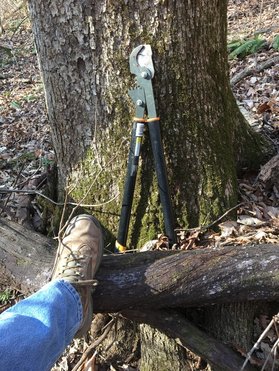 This 8” diameter vine under my foot must have been 50 years old! It was much to larger for my lopers to get around. However, my curved pruning saw cut it in no time. This 8” diameter vine under my foot must have been 50 years old! It was much to larger for my lopers to get around. However, my curved pruning saw cut it in no time. I’m in the middle of a war! A war to save my farm from the mistakes made in the past. My approach may be a little obsessive. But, I’m not afraid to admit it. I am obsessed with protecting my farm! Like many of the people I’ve meet that have family land, I want to care for it, protect it and encourage its natural environment for the enjoyment of my family, their kids, and later generations. One of the major battles in this war is with vines, kudzu being the most intense. But, this article isn’t about kudzu (you can read about my battle with this invader from Japan in the June/July 2012 issue of this magazine, also posted on my blog @ www.fyrnelake.com). Today, I want to describe another threat to our woods that is just as destructive, visually destroying the beauty of field tree lines and fence rows while slowly starving to death trees in our forests. This threat is posed by native vines that are a natural component of our local ecosystems. Normally they would pose no threat to our forest. However select cut timber harvesting and field clearing have upset the delicate balance between trees and vines, surrendering the protection of its canopy and allowing light to penetrate to the forest floor across vast areas. This additional light gives vines the advantage encouraging them to quickly ascend trees and spread out over their upper branches blocking out sunlight and slowly starving the trees to death. I shared with you in my last article (also on my blog @ www.fyrnelake.com) that I was first exposed to this threat on my original farm hike. I discovered vines intermittently covering the forest’s perimeter tree lines and, under its canopy ascending trunks and slowly killing trees. I was worried and knew something had to be done! I immediately added this battle to my growing list to protect and care for my farm. The sheer scale of the problem was intimidating! There were acres of woods and miles of tree lines. I never would have begun if I had let the size of the problem overwhelm me. I started out trying to save one tree, then another and another, taking satisfaction with each success. Over the years I’ve saved thousands of trees and I’m still working at it. In fact, fighting vines (including kudzu) has become my exercise regiment, working my upper body with loppers, clippers and a hand saw while working my lower body hiking the wooded hills of the farm. Maybe you can benefit from my efforts. Do you or your family have a farm or hunting land? Do you care about the trees surviving for your kids and their kids? Or maybe you just want to preserve the trees for harvest. No matter the reason, I’ve developed several effective strategies to win this battle against vines. I’ve also identified several very cool hand tools (weapons) that make battling vines an easier task. I would even say fun! With these tools, I can clear acres of land in a day with the confidence that I’ve tipped the scales back to the trees’ advantage. Strategies: #1) Do not cut poison ivy or poison oak vines! Poison ivy vines rarely extend their reach above the tree canopy blocking out sunlight. So cosmetic appearance would be the only reason to cut their vines. However, your own cosmetic appearance could be drastically affected when their oil sprays out on you and your clothes when cut. Getting poison ivy takes all the fun out of being in the woods! I recommend staying clear and concentrate your effort on the vines that truly damage trees. I learned my lesson the hard way. Want to know more about my experiences with poison ivy? See my article in March/April 2017 issue of this magazine or visit my blog at www.fyrnelake.com. #2) Take personal safety seriously! Dead leaning trees and broken branches are like booby traps suspended overhead that will often shift or fall when cutting vines. Don’t tell my wife, but, I’ve had more than one branch crash down beside me while I was working on a vine. I’ve now learned to ALWAYS look above and around before attacking one. When cutting in warmer weather, snakes can and will be present. I’ve been lucky. The snakes I’ve run into have always announced their presence before I’ve gotten close. However, in the summer I ALWAYS wear snake boots and keep a wary eye out for ANY movement on the ground. Not every venomous snake has rattles! Like me, you may prefer to do the majority of your vine cutting during the cooler months. Besides being snake and bug free, the absence of leaves makes spotting and cutting vines much easier. I also prefer being a little cold than drenched in sweat and attacked by chiggers and ticks. Speaking of insects, when I’m cutting in the summer I NEVER go into the woods without a light long-sleeve shirt, wide brim hat, gloves and insect spray to keep the bugs out of my hair and off my skin. Is this sounding like fun yet? #3) Use the best hand tools! I’ve tried and destroyed a lot of tools in my vine fighting efforts and have settled on four specific weapons that have seriously impressed me. The majority of the vines under the tree canopy are ½ to 2 inches in diameter, the perfect size for a good quality lopper… at least I thought! However, most of the vines I ran into were dense and a struggle to cut with standard loppers. I went through quite a few brands and models before I discovered the Fiskar 32” PowerGear lopper. It has a 3-to-1 gear ratio that multiplies your efforts and makes quick work of any vine you can fit within its blades. Something about its patented design makes it superior to any other lopper I tried, even other gear multiplying models. In fact, they’re designed so well that I’ve often successfully cut a vine way beyond its rated diameter capacity by getting a partial bite on the vine and working my way around until I’ve cut completely through! However, some vines are just too large and require heavier artillery. That’s when I bring out my curved pruning saw. I recommend the[KG1] Corona 18” razor tooth pruning saw. It’s compact, light-weight and the perfect size to cut through a large 4-8” vine in one to two minutes. Obviously a chainsaw would be quicker. But, since most of the vines I encounter can be handled by my loppers I prefer not to lug around a heavy chainsaw. Even carrying my hand saw with the loppers gets old. More than once I’ve set down my saw to cut vines from the surround trees and have lost track of where it was! After having to replace a couple lost saws, I came across what’s called a pocket chainsaw. I had never heard of it before coming across it at a camping store. It’s basically a chainsaw blade with handles that folds up and fits in a small belt pouch. It doesn’t cut as quickly as my curved pruning saw. But, I was surprised how well it does works and I haven’t lost one yet! Along the tree lines I often run into large areas of tangled small diameter vines. I started using a standard handheld hedge clipper. It cut the mass of small vines much faster than I could with the lopers, but had limited reach and its weight seemed multiplied as I stretched out to cut as many vines as I could from one place. Why did I not just step closer? Two reasons, these masses of vines were normally located along the outer tree lines of the forest which were often lined with briars. I usually had to push my way through several feet of thorny brush before I could reach a single vine. Once positioned, I wanted to cut as much as I could reach to minimize the need to push through the sea of scratching thorns. The other reason involves gullies. My farm in particular is full of gullies and many times these vine masses would stretch out over a gulley just out of reach of my standard clippers. As Tim Taylor would say in the TV show Home Improvement, “I need more POWER!” I sought out and found from a place called Gempler’s, the lightweight ARS HS-K900Z telescopic hedge shear. The handles are aluminum while the blades are stainless. I especially like the telescoping feature that allows me to stand in one place and reach three times as far as before. I was impressed! I now had all the tools I needed! 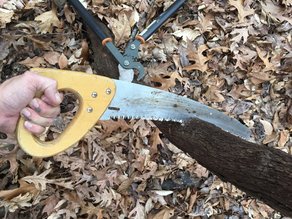 Here’s my 3 to 1 geared lopers getting its teeth around a good sized vine. Once I had it fully surrounded, there was one less vine in my woods. 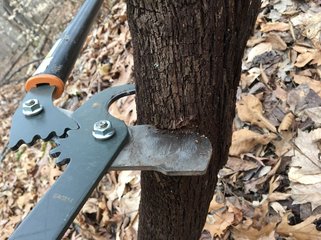 Here’s my 3 to 1 geared lopers getting its teeth around a good sized vine. Once I had it fully surrounded, there was one less vine in my woods. 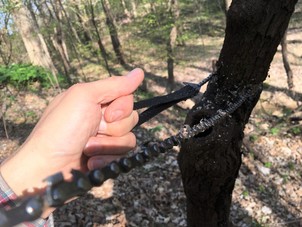 What I love about this hand powered pocket chainsaw is how it fit’s compactly in a small belt pocket. It cuts well too! #4) Spray a glyphosate based herbicide like Round-up. Just cutting the vines where sunlight is abundant along the tree line isn’t enough to get rid of them. I’ve found that it’s necessary to circle back through a few weeks later to spray any sprouting vine stumps. The good news is I’ve discovered that it’s seldom necessary to spray the vines that I’ve cut under the tree canopy… unless it’s kudzu! Kudzu’s roots store such a reserve of energy they can easily climb back up the tree. Native Tennessee vines quickly deplete their energy reserves in the limited light while attempting to climb back above the canopy. For added insurance, I make it more difficult for them by cutting each vine twice, once near the ground and once close to chest level. This gap is usually sufficient to keep the vines from taking the easy way back up the tree on what’s left of their now dead upper member. They’re forced to attempt the only way left, up the larger diameter tree trunk. So, are you ready to have fun yet? Or, do you think I’m crazy? My wife probably thinks so. She’s seen me head out into to the woods countless times to cut vines and returned dead tired, drenched in sweat, covered in dirt and wearing a huge smile. That smile is even wider these days. It’s difficult to describe the deep feeling of accomplishment I experience when hiking through now healthy (and mostly vine free) areas of the farm. I also feel in my bones (literally) that this effort has keep me more fit and feeling young. It’s not too late for you to have the same experience saving your own trees! Don’t have your own? I might even let you cut a few of my vines. (I also have a fence that needs whitewashing.) I’ve already figured out a system that works well for me and it will work for you. All that it will take is respect for poison ivy, awareness of what’s above your head and below your feet, the purchase of a few awesome tools to make the task easier and an abundance of patience. Patience will serve you well as you free one tree at a time. Depending upon the size of your woods, the task of freeing it all may take years. Staying focused on your goal and taking satisfaction with each freed tree will help you keep motivated. I can assure you the results you’ll attain are worth it. You may just become as obsessed as I am! My telescoping clippers helped me clear out this tangled mess of vines in about 10 minutes. Check out the before and after pics. The absence of leaves in the winter reveal how the vines are devastating the forest. It’s hard for me to hike by a scene like this without cutting a few.
Comments are closed.
|
AuthorKevin Griffith Archives
September 2018
Categories |
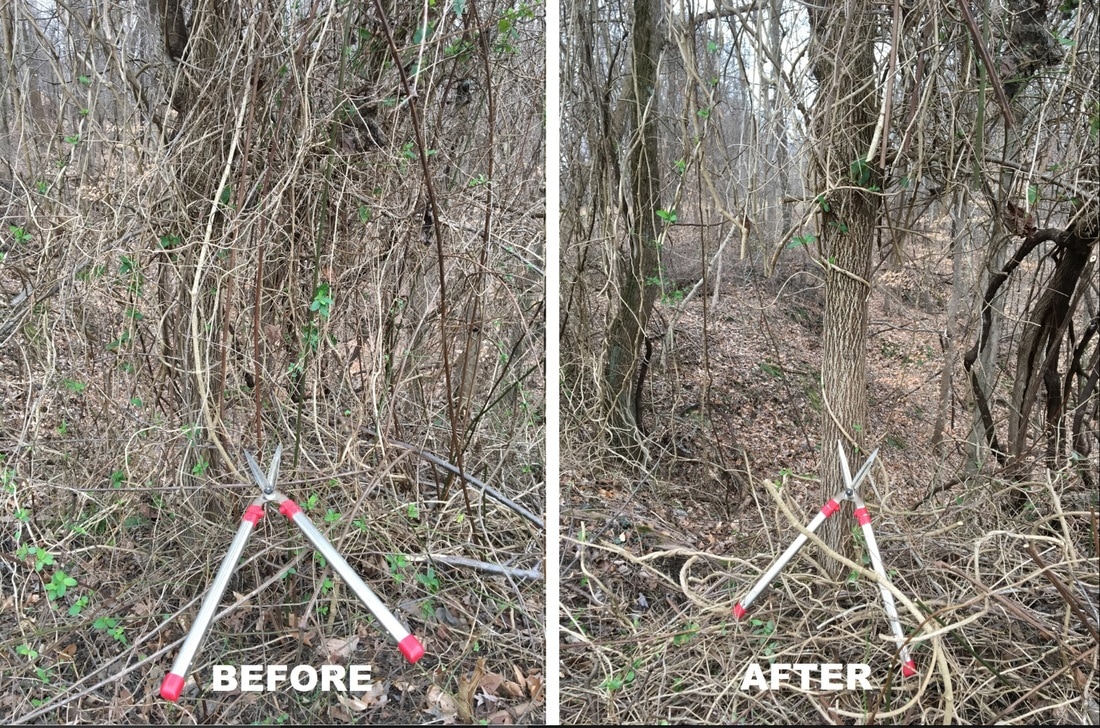
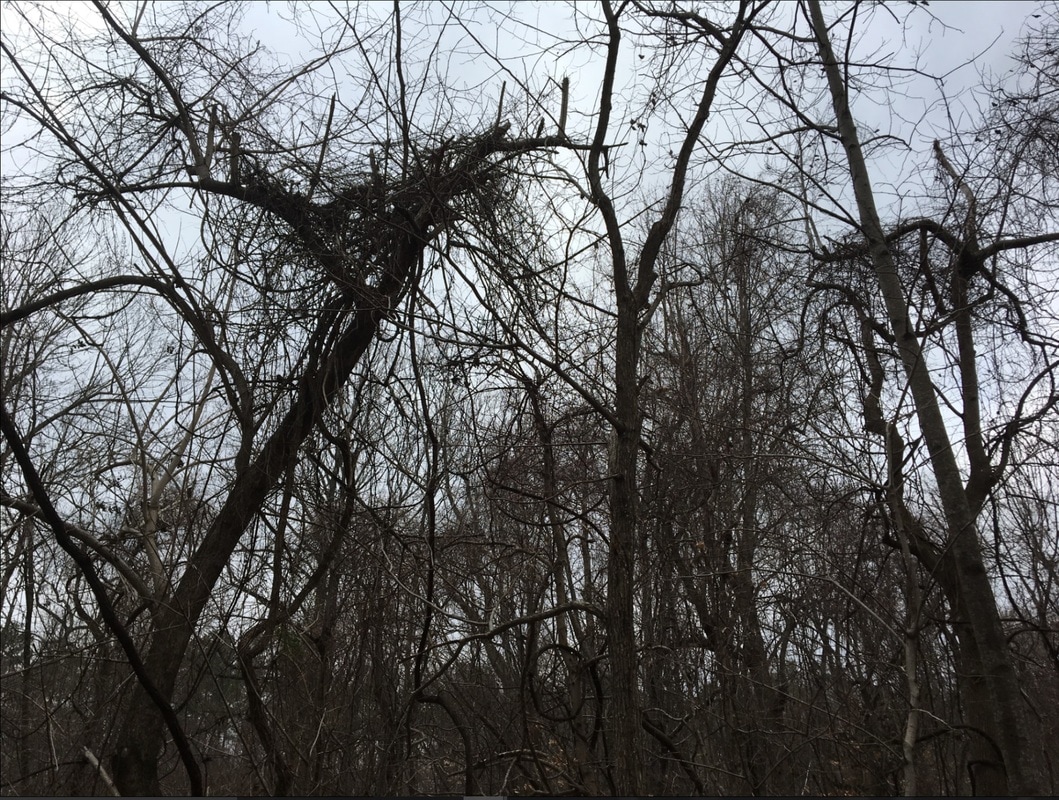
 RSS Feed
RSS Feed